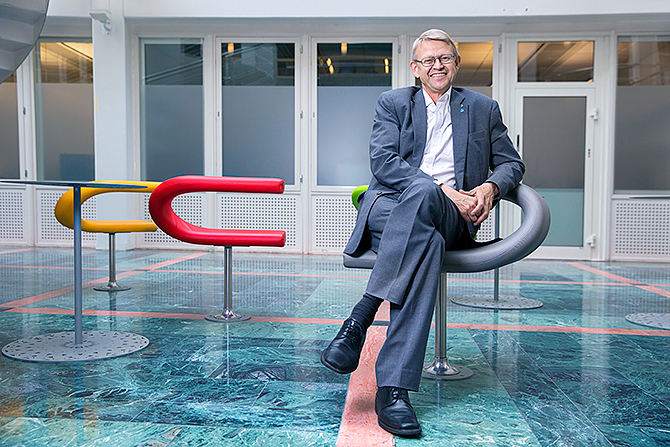
Mikael Östling nominated as Deputy President
Mikael Östling has been nominated as the new Deputy President of KTH Royal Institute of Technology. Östling comes to the role from his current position as a researcher and head of department at Kista and brings considerable experience to the institute’s top management.
“It feels amazing,” he says. “I have been at KTH for many years in a variety of positions and I’ve truly enjoyed it. Now I get the chance to work for KTH’s best at the uppermost level of management.”
A nomination committee nominated Östling to the Board as the new Vice President following a selection process. Of the 24 candidates being considered Östling best matched the committee’s requirements for the role.
“Mikael is a proactive and an extremely competent person,” says Sigbritt Karlsson, KTH’s incoming President, who has been a driving force in the process and had the task of selecting candidates for the committee. “He has a strong focus on quality when it comes to all of KTH’s areas of operation, including education, research and collaboration. Relationships with the rest of the world are important to KTH, and Mikael has extensive experience with – and a commitment to – the impacts and benefits of research, be it in a national or international context.”
Östling has been with KTH since the mid-1980s. He played a key role in helping to build up the research operation at KTH’s then newly established Kista campus and has since held a range of leading roles, including Head of Division, Head of Department, and Dean of the School of Information and Communication Technology.
“Here at Electrum, I have worked at a smaller campus with the business community right next door and several research institutes on site,” he says. “This provides me with something a little bit different in terms of my experience, and I want to contribute with this.”
An issue close to Östling’s heart is collaboration between the world of research and the surrounding community. He is involved in KTH’s Impact Project and hopes to see this area further developed, particularly when it comes to links with local businesses. He hopes that KTH’s strategic partnerships will be strengthened even further.
“Research needs to have several areas of focus,” he says. “It must be long term to secure our position as a university of technology, but in the shorter term it also has to be needed by the business community and to provide direct benefit for society.”
Östling places research quality at the top of the agenda and wants KTH to carefully prioritise which areas are most important. “We need to review how we should invest in the future,” he says. “I want us to put resources into activities that are of high quality in terms of research. This is crucial to moving up the global ranking lists.”
Östling’s ambition is to help grow the climate of interdisciplinary cooperation between KTH’s schools. “There are already several examples of projects that bridge the gaps between schools,” he says. “I want to see more examples of broad, positive collaboration and I’m hoping for more use of a borderless approach, without creating tension between the schools.”
On his leadership, Östling says, “I love getting people on board by inviting them to engage in a productive debate on ideas. I’m not into blowing people out of the water, but rather listening to what people have to say. If we agree, I want to quickly get the ball rolling.”
Östling is looking forward to working with Sigbritt Karlsson. They have worked together previously and were in the first round of deans when KTH was restructured from departments into schools in 2004.
“That’s particularly pleasing,” Östling says. “We share the same values regarding research and education and have the same view of which priorities are most important.”
According to Börje Ekholm, the Chair of the nomination committee, Mikael Östling proved to be extraordinarily qualified in the nomination process.
“There are many things that, taken together, make him suitable for the role of Deputy President,” he says. “Mikael has excellent scientific expertise, broad experience, strong external contacts, high integrity and a heart that beats for KTH.”
Text: Christer Gummeson

